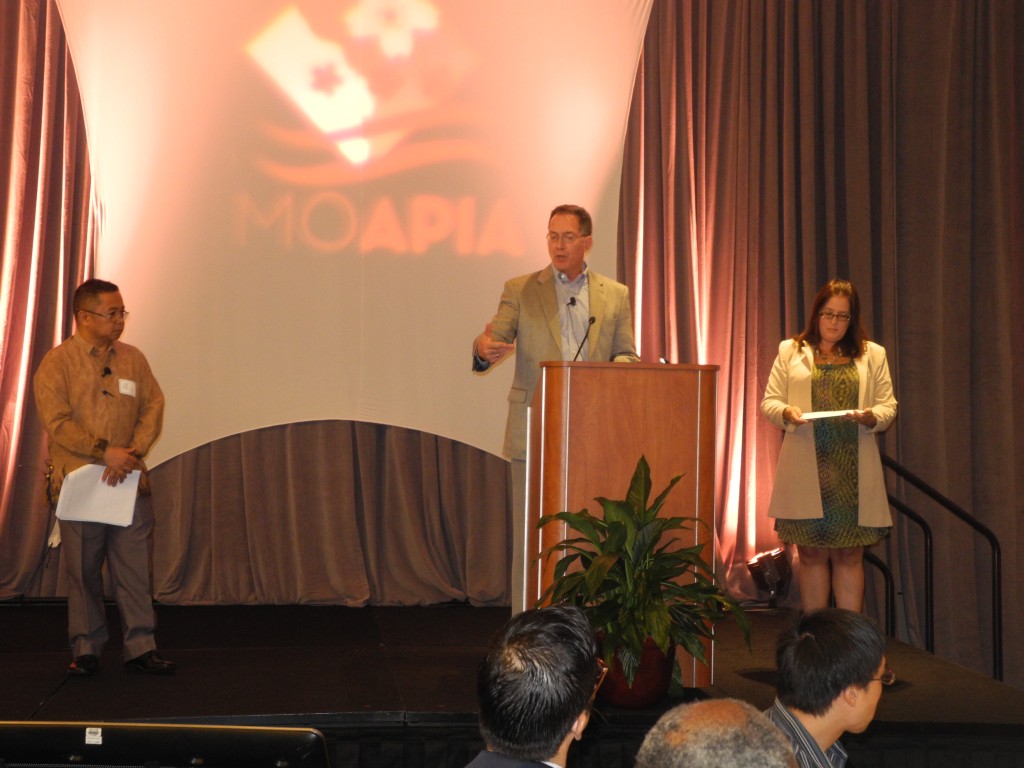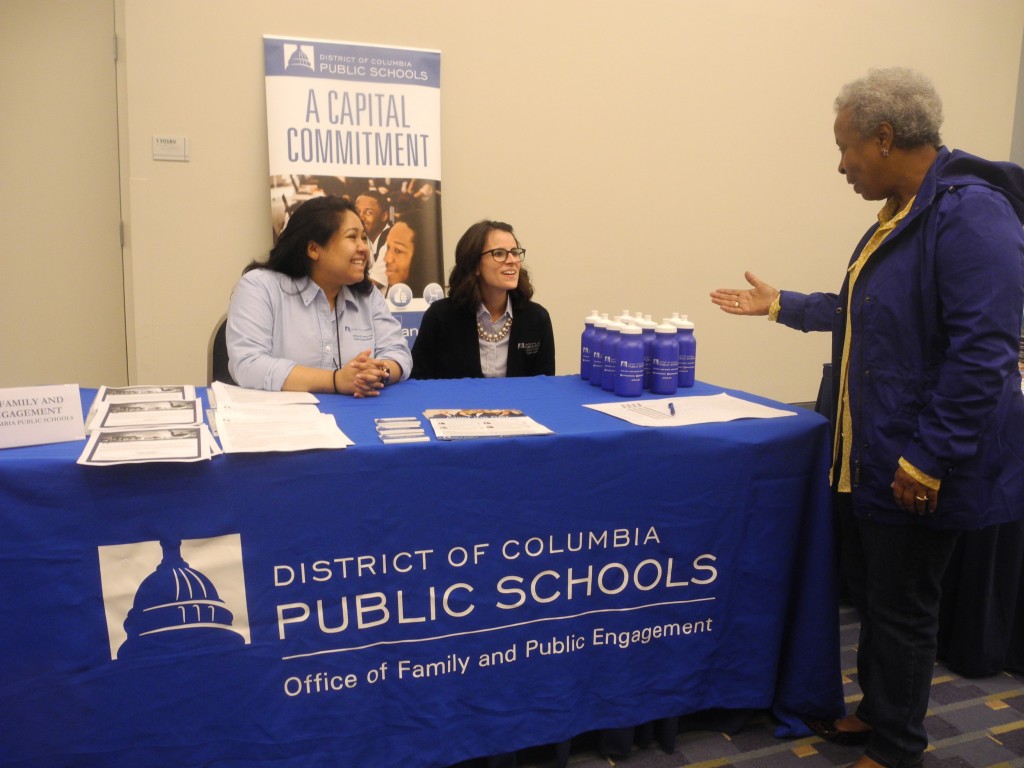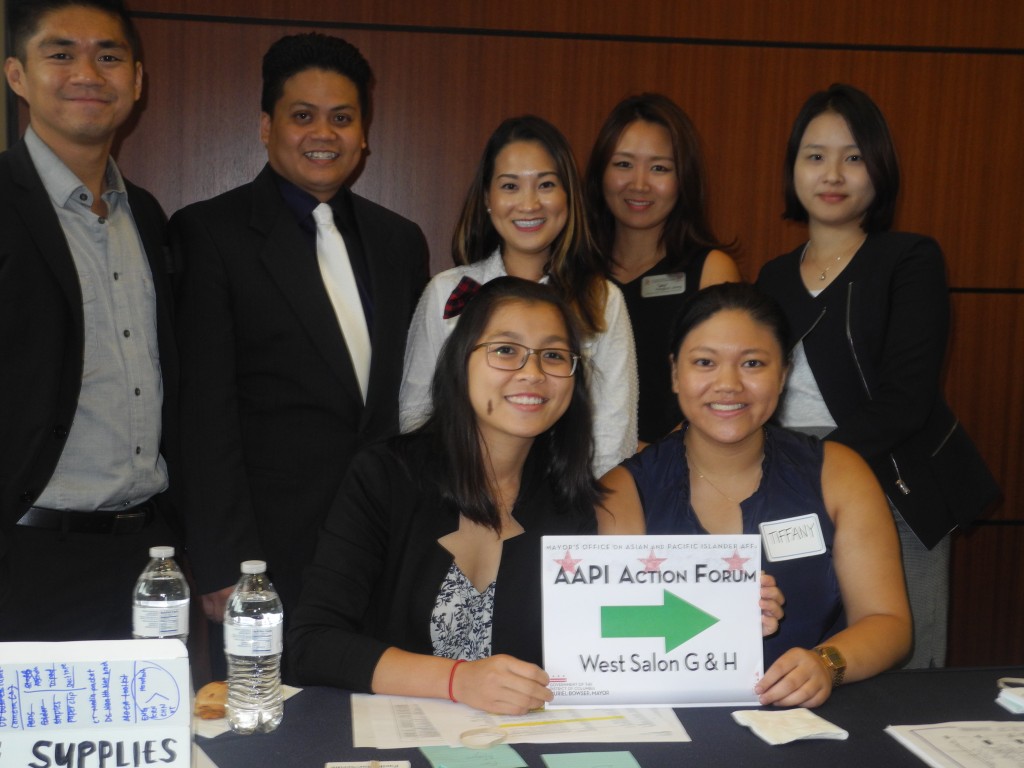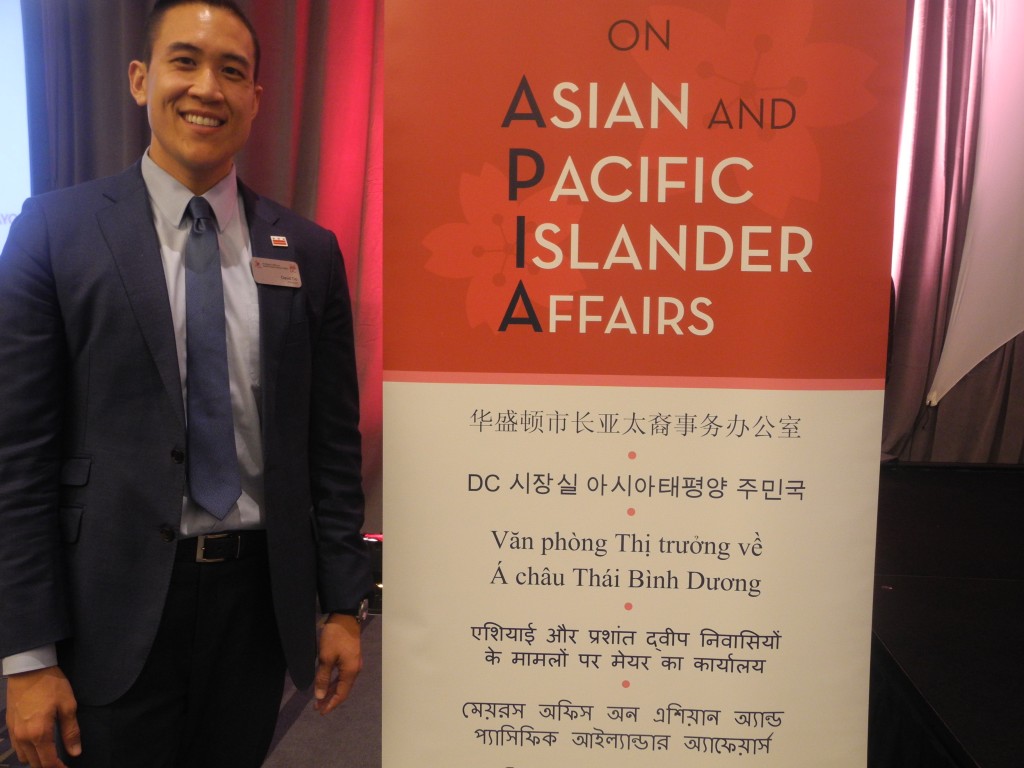By Jennie L. Ilustre

Washington, D.C.–All-day rain and wind gusts, not to mention football games, enticed most people to stay at home. And by the way, the event was on a weekend. But Asian Americans, known for their work ethic, showed they are civic-minded as well.
Some 200 District residents, 73 per cent of whom were Americans of Asian heritage, took part in the successful, five-hour Action Forum organized by the Mayor’s Office on Asian and Pacific Islander Affairs (MOAPIA) on September 12. Venue was the Washington Convention Center in the nation’s capital.
The forum had two goals. First, identify specific action priorities for the Asian American and Pacific Islander (AAPI) community on health care, public safety, youth education, adult education and job training, small business engagement and affordable housing. Second, find out how the District government “can work more collaboratively with residents across different cultures and ethnic backgrounds.”
Citing specific programs, the speakers emphasized that “there are more opportunities out there” and more and improved programs than ever before to serve District residents. A lively inter-active True or False keypad polling with correct answers shown on two huge screens near the stage focused on misconceptions about education.

The key speakers were Superintendent Hanseul Kang of the Office of State of Superintendent of Education, Director Polly Donaldson of the Department of Housing and Community Development and Elba Garcia, Director of the DCSPS Language Acquisition. (For more information on programs and services for Americans of Asian descent, visit the website www.apia.dc.gov or call (202) 727-3120.)
Findings
Participants used keypad polling to register their views on priority issues. The forum utilized methodology from the non-partisan Public Engagement Associates led by its principal, Steve Brigham. Brigham co-emceed the forum with Associate Professor Al B. Fuertes of George Mason University’s New Century College.
The views and suggestions of some 150 Asian Americans surveyed are helpful as a snapshot representing nearly 30,000 residents of Asian ancestry. (The full report, with Mandarin, Cantonese, Vietnamese and Korean translations, will be available on MOAPIA’s website, www.apia.dc.gov, on September 21.)
Six out of ten participants were Chinese Americans. The rest: Vietnamese American, 10%; Korean American, 9%; Filipino American, 5%; Asian Indian, 2%; Pacific Islander, 1%, and Asian American of other origin, 14%. Highlights of the preliminary findings follow.
Public Safety
Participants identified the most important ways for communities and government to work together more effectively.
42% of the participants, or four out of ten, suggested addressing issues underlying violent crime (poverty, education, homelessness and jobs)
41% Increase community policing; more communication from the Metropolitan Police Department (MPD) to the community. Officers knowing residents, business owners and our languages
30% Better nighttime security presence–increase visibility of police, adding more and better lighting
30% “Realize that people relying on the police may not trust them and build the relationships from the ground up”
23% More gun regulations
21% Cultural sensitivity training for all MPD offices
Health Themes
What are the important actions for government to take to serve vulnerable populations better?
37% said, More access to health services for seniors, as well as better options for affordable health insurance
35% Increased access to language services
33% Connecting D.C. agencies to communities, increasing outreach. For instance, have bilingual forms available through public schools
29% Create mobile clinics or better access to transportation to hospitals
19% Increase options for mental health therapies
15% Better options for coverage and knowledge of alternative medicine in tandem with conventional medical care.
14% Provide healthy food in grocery stores and school lunches to ensure good nutrition
Education: D.C. Public Schools (DCPS) and Charter Schools
There was some confusion among participants, as there is in the larger D.C. community, about the difference between D.C. Public Schools and Charter Schools. Half (51%) of the participants thought that charter schools have far fewer students than DCPS. But the right answer–identified by 36% of participants–is that both sets of schools have roughly the same number of students.
Participants also considered two questions.
What can the D.C. government do to ensure our children receive an education that effectively addresses the language access and cultural sensitivity challenges they face? Here are themes they identified:
- 49% or half of the participants said, More cultural competency training for both parents and teachers
- 48% Increase language resources for families (not just for students). Getting official interpreters to communicate between teachers and ELL parents instead of unofficial translators.
- 38% Evaluate the effectiveness of current DCPS programs and have consistency across programs
- 37% Match up students from different backgrounds (peer mentoring) to learn from each other and to ease the transition into DCPS
- 16% Reduce class size to give students more individual attention.
What can the community do to ensure our children receive an education that effectively addresses the language access and cultural sensitivity challenges they face? Here are the themes they identified:
- 46% of the participants said, Support out-of-school opportunities for youth (that is, tutoring programs)
- 41% Offer more mentoring programs like Big Brothers/Big Sisters, Boy Scouts/Girl Scouts, Asian American LEAD)
- 34% of the participants said communities need to emphasize the importance of education
- 22% “Foster intergenerational communication”
- 21% Prevent bullying
- 21% Encourage parental involvement
Adult Education and Job Training
What are the important things the government–and our communities–can do to ensure that our residents get the training they need to move to better, higher paying jobs and careers?
- 46% of the participants said, Encourage public/private partnership as a partway to providing jobs
- 46% Develop more training programs focused on skills required for better paying jobs
- 30% Provide stipends for child care and transportation for people going through trainings
- 19% Government needs to get the word out on their programs
- 16% Implement language training to address barriers
- 14% Provide night classes for those working during the day
- 11% Create formal soft skills training to address cultural differences
What Our Communities Can Do Better to serve the vulnerable (examples provided by participants):
- Volunteer to help “bridge the communication gap” and provide interpretation services.
- Share and raise awareness about resources (i.e. through community organization, churches and at festivals)
- Incorporate more cultural sensitivity in community meetings to make everyone more relaxed and engaged
- Health providers (example: CVS) should provide language resources, doctors and staff who can speak their language
- “Be active and vocal” to communicate our needs to government
- Ensure senior centers provide information services available in different languages
Top Concern
Recently, the District has seen an alarming spike in its crime rate. Public safety was among the participant’s top concerns, based on on-site interviews, and they linked crime prevention with solutions on education, poverty, jobs and homeless issues.
Remarked Korean American interpreter Sung Yang, facilitator in one discussion group: “We are talking about how education is related with crime prevention. If you do not have education, you tend to get involved with crime.”
Facilitator Long Dinh of Table 15, composed of Vietnamese American participants, said, “They link poverty, unemployment and homelessness with crime. They want the police to patrol the areas with the homeless.”
Filipino American teacher Elmer Sison in a child care facility, said the discussion in his group emphasized “the need for enhanced sensitivity to cultural differences, and good police relationship with the community.”
Sison acknowledged the federal and D.C. governments have several programs of services. “But lots of people do not know about existing programs and new information on Obamacare and Medicaid that affect them. We talked about the need for public awareness, how people can avail themselves of the services and accessibility.”

Sgt. Kenny Temsupasiri, head of the Asian Liaison Unit, confirmed that heeding the public clamor to field more police on patrol, the District promptly hired a civilian to perform the administrative work in the office, instead of rotating the police officers in the unit. His unit is composed of five Asian Americans of Korean, Vietnamese, Thai, Mandarin and Cantonese heritage. He said Lt. Cheryl Crawley was in charge of the Special Liaison Division
Pastor Richard Ross of Chinese Community Church, also stressed the role of faith. Showing a flyer, he invited others to join the conversation on “Upsizing Life by Downsizing Stuff” on October 1 at 7-8 p.m. Venue is the LifeTree Café on 502 I (Eye) Street NW. Pastor Ross was wearing a T-shirt with the slogan, “An hour of stories and conversation to feed your soul.”
In related news, three days after the Action Forum, the advocacy group South Asian Americans Leading Together (SAALT) co-sponsored the Muslim American Women’s Policy Forum, “Neighborhood Safety and Hate Violence.” It is the first of eight city-wide forums with the ACLU among the sponsors. Attendees raised concerns on “hate violence, community safety and policing, and law enforcement responses in the District.” The forum was one of eight city-wide forums the ACLU will co-sponsor in D.C.
Health care was another top concern with Hoc Huynh, 80, and Le Huong, 73, who actually look younger than their age. Speaking through an interpreter, Ms. Huong said she needs Medicare Part A.
Group Discussions
Aside from expressing their views through on-site keypad polling on issues, participants also engaged in group discussions on how the city can better meet their needs.
Facilitators and interpreters in Chinese, Korean and Vietnamese languages helped the older participants–about 25% were 65 or older–communicate their concerns and suggested solutions. The event included Latino and African immigrant residents to encourage multi-cultural cooperation on common concerns.
The participants were mostly young: 24 and under (10%); 25-34 (21%); 35-54 (22%); 45-54 (22%) and 65 and older (25%), with a nearly balanced mix of male and female. Four in ten had an Annual Household Income of $75,000. The rest: $50,000-74,999 (13% of participants); $25,000-49,999 (12%), and under $25,000 (23%). All the wards were represented, with most (21%) coming from Ward 2. Many are long-time residents, and 7% have lived in D.C. for less than a year.
There are 27,000 Americans of Asian heritage in the District. Of this figure, Chinese Americans (24.8%) and Asian Indians (24.7%) make up half of the total AAPI population, followed by Filipino Americans (12.7%), Korean Americans (10.8%) and Vietnamese Americans (7.4%).
The civil rights advocacy group South Asian Americans Leading Together (SAALT) urged attendance through its website with the heading, “Your Voice Has a Direct Impact…Help Shape MOAPIA’s Future Initiatives.”
During this year’s Asian American Heritage Month last May, Mayor Muriel Bowser recognized the diversity and contributions of Asian Americans. “There are more than 27,000 Asian American and Pacific Islander residents who have woven their traditions and heritages into the ethnic fabric of our world-class city and helped shape the District through their civic engagement, entrepreneurship, and philanthropy.”

OAPIA Director David Do noted that “we all come from vastly different backgrounds and upbringings…but we should all come together to promote and support each other.”
Essentially, what took place on September 12 was a Talk and Listen Forum that, as planned, came up with suggested solutions and directions that the District government can take, in partnership with stakeholders and working together with the residents.
More important, the forum should have an Action and Progress Report from the Mayor’s Office on Asian and Pacific Islander Affairs (MOAPIA) within a reasonable timetable. Calling for a Progress Report is a task tailor-made for Asian American advocacy organizations.
 Asian Fortune Your source for all things Asian American
Asian Fortune Your source for all things Asian American




